

Scoping AngularJS Directives Part 1. AngularJS directive scoping confuses a lot of people.

I thought I would take a moment and attempt to defuse some of the confusion. First I encourage you to visit the AngularJS developer guide on directives: To simplify you should know that there are only three types of scoping with directives: inherit scope from the nearest controller scope [default]create a new scope that is prototypically inherited from the nearest controller scope [scope: true]create an isolated scope that only has access to the nearest controller scope via parameters or the $parent property. [scope: {}] First, lets take a looksy at scope type 1: inherited scope.
You can see that we have direct access to $scope.property which is created within the nearest controllers scope. Next, lets take a look at scope type 2: new child scope You can see that we have access to $scope.property via the prototype chain. Build custom directives with AngularJS. Most everything we use in AngularJS is a directive.
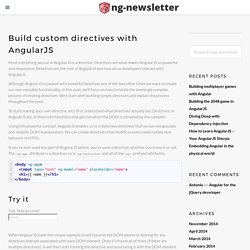
Directives are what makes AngularJS so powerful and responsive. Directives are the root of AngularJS and how we as developers interact with AngularJS. Although AngularJS is packed with powerful directives out of the box, often times we want to create our own reusable functionality. In this post, we’ll focus on how to tackle the seemingly complex process of creating directives. We’ll start with building simple directives and explain the process throughout the post. When to use directives, controllers, or services in Angular JS. Angular JS is a very powerful front-end MVC framework.
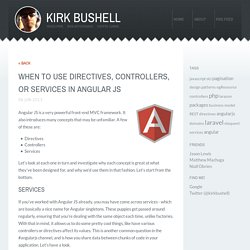
It also introduces many concepts that may be unfamiliar. AngularJS - Directive to Directive Communication. Use Ng-bind in AngularJS : Fundoo Solutions. AngularJS makes it easy to get your data from your JS controllers into the template.

Just use double curly braces!! ({{ }} in case you were wondering). And why wouldn’t you? It makes your HTML very readable, and makes it obvious that you are referring to a JS object / variable when you encounter it. AngularJS Directives Tutorial - Fundoo Solutions : Fundoo Solutions. In the very first of our series, we decided to focus on a majorly misunderstood and highly complicated (atleast at first glance) part of AngularJS .
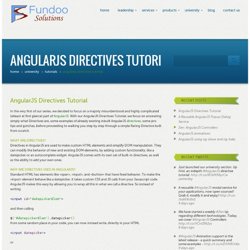
With our AngularJS Directives Tutorial, we focus on answering simply what Directives are, some examples of already existing inbuilt AngularJS directives , some pro tips and gotchas, before proceeding to walking you step by step through a simple Rating Directive built from scratch. What are Directives? Directives in AngularJS are used to make custom HTML elements and simplify DOM manipulation. They can modify the behavior of new and existing DOM elements, by adding custom functionality, like a datepicker or an autocomplete widget.
AngularJs Find Element in Context - Jake Trent. Finding an element in context means that I can select a node from the dom within a certain range – specifically either a node or any of its children nodes.
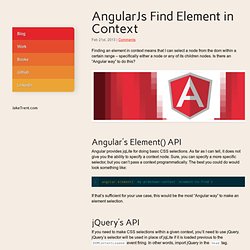
Is there an “Angular way” to do this? Angular’s Element() API Angular provides jqLite for doing basic CSS selections. As far as I can tell, it does not give you the ability to specify a context node. Sure, you can specify a more specific selector, but you can’t pass a context programmatically. If that’s sufficient for your use case, this would be the most “Angular way” to make an element selection. jQuery’s API.
v7 propertyeditor how to add an angularjs directive - Extending Umbraco. Dynamically Loading Controllers and Views with AngularJS and RequireJS - Dan Wahlin. Dynamically Loading Controllers and Views Updated: August 30th, 2014 A complete sample application that uses the techniques shown in this post can be found at AngularJS provides a simple way to associate a view with a controller and load everything at runtime using the $routeProvider object.

Routing code is typically put in a module’s config() function and looks similar to the following: While this type of code works great for defining routes it requires controller scripts to be loaded upfront in the main shell page by default. This approach works well in cases where you don’t want all of your controller scripts loaded upfront, but it still doesn’t feel quite right – at least to me. Notice that a single value is passed into the route.resolve() function. Dynamically Loading Controllers The following diagram shows the different players involved in simplifying routes and dynamically loading controllers. Behaviour of Scope in AngularJS Directives. 0inShare Directive is the coolest and most crucial feature provided by AngularJS.

Use of the scope property in directives makes the process of writing a directive challenging. The behavior of the scope depends on the way it is assigned in the directive. The 80/20 Guide to Writing AngularJS Directives. AngularJS is blowing up right now, and with good reason.

There’s nothing more satisfying than using AngularJS to turn 1,000 messy lines of Backbone.js and jQuery spaghetti code into a trivial 10 lines. To put it in a broader context, you can think of AngularJS’ place in the world this way: AngularJS is to jQuery as C++11 is to x86 Assembly. However, your quest to capture all the wonderful benefits of AngularJS may be hindered because the documentation is a bit difficult to wrap your mind around. In particular, many readers have told me that the documentation for directives is pretty intimidating, and a lot of experienced users still don’t quite grok how to use them properly. First of all, let’s take a moment to recognize that you’re almost certainly not the only one confused. For most of you, the reason that you’re writing directives is probably pretty straightforward, such as to integrate with existing Bootstrap modules and jQuery extensions, or to DRY up your UI. 1. 2. 1.
Developing Angular.js Directives. Want to build web sites faster?
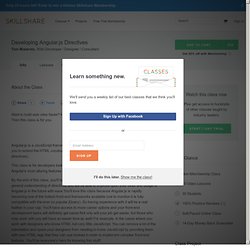
Have cleaner, easier to read, HTML and JavaScript code? Then this class is for you. Angular.js is a JavaScript framework built by Google and one main feature is that it allows you to extend the HTML vocabulary with new tags or elements (through Angular's directives). This class is for developers looking to make their coding life easier by implementing one of Angular's most alluring features - directives. By the end of this class, you'll have created a re-usable directive.
You'll love this class because Angular.js is rapidly becoming one of the hottest front-end frameworks available (not to mention it is fully compatible with the ever so popular jQuery). Not only will your job get easier, but those who may work with you will have an easier time as well! How to Write a Simple AngularJs Directive. After using AngularJs for awhile I needed to extend the built in $filter("currency") to add a bit of css magic to some of my elements.
I wanted to add a class to the text so I can style the element to give it a distinct look for positive and negative values. I also did not want to reinvent the currency filter. Angular: The Component Orientedness It Makes Me Happy And Why. Being a geezer programmer ain’t all bad. True, sometimes it’s incredibly annoying to those around us: “Back in my day we had a trash 80, a cassette player, and some duct tape AND WE LIKED IT!”.
But other times, we get to look back over decades of programming with some valuable perspective. I’ve been doing web development in some form since about the time there was a web, let’s say mid to early nineties. I’ve recounted all the phases we went through in other posts and I won’t bore you with that now. Angularjs - Directive isolate scope with ng-repeat scope. AngularJS Directives. Last week I started in on learning AngularJS and putting it to work on the app at my new company, FinderLabs. I have a long post coming up detailing what I’ve learned about setting up an AngularJS page backed by a simple Rails API, but for today I just wanted to jot down some notes about creating an AngularJS directive, because I found it pretty painful figuring it out — some of the AngularJS docs are quite good, and some of them are lacking.
Thankfully there are a lot of examples out there, but I had to look over too many of them to get this working. Note that I’m only moderately comfortable with JavaScript coding, so your mileage may vary. So, what I wanted to was really easy with plain old jQuery, but it turned out to be more complicated when AngularJS entered the picture. Inside a list of items, for each item I had a DIV into which I was rendering a line graph, using Flotr2, and I had to pass it the JSON data needed for the charting. Here’s the relevant markup from the page: The traveling hermit: AngularJS Missing Directives: Focus & Blur. After my last post discussing the missing native form reset directive, I was asked what other missing directives there might be. Which is a great question. AngularJS provides so many great directives out of the box, what could it possibly be missing? Well, lets start with simple user input events. Directives and components.
The concept of directive is the most interesting feature of this framework. It is also one that is closest to our web framework in Java: creating reusable components. A directive able to (re)define HTML tags and extend the language to give the properties of a DSL (Domain Specific Language). AngularJS provided a set of guidelines as the basis for designing a web application. How to declare a directive can vary to be adapted to the rules of HTML (XHTML, XHTML strict, etc). In the JavaScript code the syntax is the same as Java (CamelCase) which myElement can be decline in 5 way my:element, my_element, my-element, x-my-element, data-my-element .
Below is an example of based directives ng-repeat and ng-include whose name clearly indicates the function. Use Ng-bind in AngularJS : Fundoo Solutions. AngularJS Directives Tutorial - Fundoo Solutions : Fundoo Solutions. We, at Fundoo Solutions are proud to announce the launch of our University Section where we will be discussing and posting some interesting tutorials, tips and tricks and case studies from our experiences.
We are rolling out the Tutorial section with an indepth dive into AngularJS Directives. Run a directive after the DOM has finished rendering. The problem Let’s suppose you have a custom directive, repeatHelloWorld. This directive has the important task to log the message “hello world!” In the console, and repeat this operation for the number of times specified by the parameter accepted by the directive, and defined in the controller. Everything seem to be ok, but when you run the page, the console remains empty. Create AngularJS Directives to Remove Duplicate Codes in Form - Kazi Manzur Rashid.
In my recent post I presented few form templates which was full of duplicate codes. Extending HTML with AngularJS Directives. AngularJS Directives Tutorial - Fundoo Solutions : Fundoo Solutions. AngularJS Tutorial — Build an App Using Directives and Data Binding. AngularJS is quickly gaining a reputation as one of the most forward-thinking JavaScript frameworks around, with good reason. Backed and developed by Google, Angular takes an approach to your front end that may seem a little odd at first, but you’ll soon wonder why you did things any other way. Angular gives developers the ability to write front end code without resorting to directly manipulating the DOM.
This tutorial will get you started with the framework by building an app using directives and data binding to define dynamic views and controllers. If you’re familiar with CoffeeScript (not required by Angular) you’ll have more fun with this article, but a working knowledge of JavaScript should suffice. You’ve likely seen a bunch of Todo apps before, so let’s build something fun — noughts and crosses! AngularJS - Dependency Injection, Modules, and Services. Dynamic Directives with Angular. Having recently embarked on a Single Page Application (SPA) for one of my clients, the technology landscape is pretty vast.
Without going into much detail, I settled on AngularJS as one of the many javascript libraries. Angular is pretty robust with a wealth of options required of spas. [I looked at a few others, such as KnockoutJS and Durandal. Dynamically Loading Controllers and Views with AngularJS and RequireJS - Dan Wahlin. DRYing AngularJS Directives - Panther Software. Build custom directives with AngularJS. Angularjs - When writing a directive, how do I decide if a need no new scope, a new child scope, or a new isolate scope. AngularJS directives and the computer science of JavaScript. The past few years have been extremely kind to the JavaScript developer. Not only has JavaScript become the dominant language now surpassing even Java, but the level of tooling that is available in the space is absolutely unprecedented.
When it comes to picking a framework for your application, you have a cornucopia of choices. AngularJS Directives That Override Standard HTML Tags. Photo Credit: Maximilien Brice Directives are the heart and soul of AngularJS. They are incredibly powerful. Using AngularJS? Stop using jQuery as a crutch. AngularJS Tutorial — Build an App Using Directives and Data Binding. AngularJS Directives - Basics. AngularJS Directive Tutorial. Communication Between Directives in AngularJS. Understanding Directives · angular/angular.js Wiki. Addon functionality for built-in directives in Angular. Directives in AngularJS. Angular Directives Tut is in Dev.../Resources Folder... Custom Validation via Directives. Directive Basics. Directives Tutorial - Fundoo Solutions.